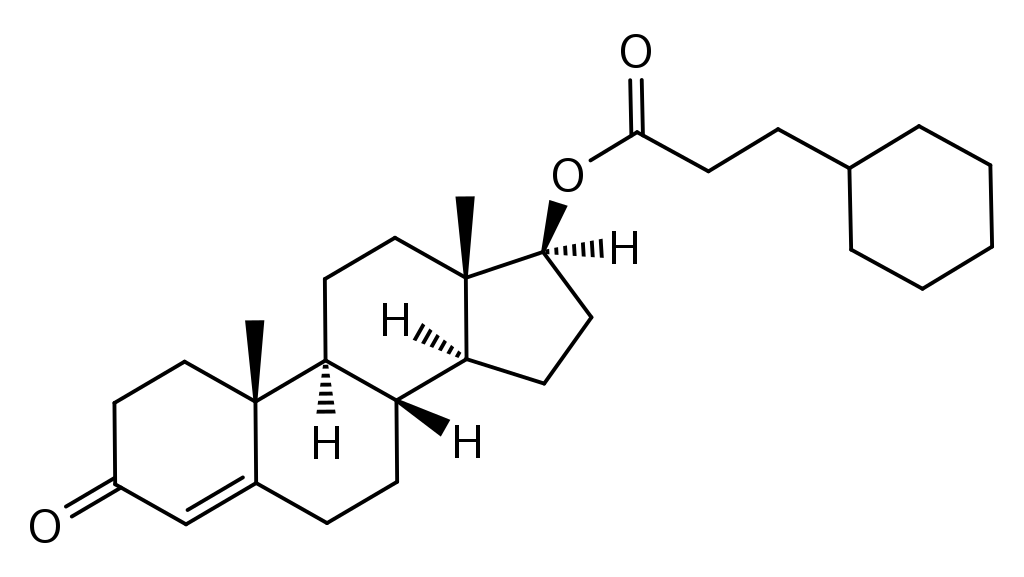|
(Image courtesy of Aethyta, Public domain, via Wikimedia Commons) Testosterone is the primary sex hormone in males and is responsible for the development of male reproductive tissues (e.g., the testes and the prostate), as well as secondary sexual characteristics such as increased muscle mass and the growth of body hair. It is found in men and women, and is integral in regulating health and well-being, including maintaining bone mass. Testosterone is a steroid, a large class of organic compounds that includes hormones, vitamins, and more. It is secreted by the testicles of males and the ovaries of females, though the levels are significantly higher in men (around 7-8 times as much). It can be used as a treatment for breast cancer in women, and older men can be prescribed testosterone treatments as levels in men decrease with age. For adult men, testosterone is vital for sperm development as it activates Sertoli cells. These are a specialized cell type found in the testicles, specifically in the seminiferous tubules of the testes, and they facilitate the production of new sperm. Testosterone levels increase during sexual arousal in males and females, though to a greater degree in men. Interestingly, both the act of falling in love and becoming a father correlate to decreased levels of testosterone in men, with the latter believed to be related to promoting paternal care. Nuts & Bolts: Testosterone To learn more about, please visit our series of posts about male reproduction and contraception: Key terms: Hormone - a regulatory substance produced in an organism and transported in tissue fluids such as blood or sap to stimulate specific cells or tissues into action. Ovulation - the release of an egg during menstruation in females. For additional terminology related to male contraception and the male reproductive system, please visit our glossary: Sources/References: Haynes WM, ed. (2011). CRC Handbook of Chemistry and Physics (92nd ed.). CRC Press. p. 3.304. ISBN 978-1439855119 Mooradian AD, Morley JE, Korenman SG (February 1987). "Biological actions of androgens". Endocrine Reviews. 8 (1): 1–28. doi:10.1210/edrv-8-1-1. PMID 3549275. Luetjens CM, Weinbauer GF (2012). "Chapter 2: Testosterone: Biosynthesis, transport, metabolism and (non-genomic) actions". In Nieschlag E, Behre HM, Nieschlag S (eds.). Testosterone: Action, Deficiency, Substitution (4th ed.). Cambridge: Cambridge University Press. pp. 15–32. ISBN 978-1-107-01290-5. Dabbs M, Dabbs JM (2000). Heroes, rogues, and lovers: testosterone and behavior. New York: McGraw-Hill. ISBN 978-0-07-135739-5. "Testosterone". Drugs.com. American Society of Health-System Pharmacists. December 4, 2015. Kalat JW (2009). "Reproductive behaviors". Biological psychology. Belmont, Calif: Wadsworth, Cengage Learning. p. 321. ISBN 978-0-495-60300-9. Ganong (2012). Ganong's Review of Medical Physiology (24 ed.). TATA McGRAW Hill. pp. 423–25. ISBN 978-1-25-902753-6. Fox CA, Ismail AA, Love DN, Kirkham KE, Loraine JA (January 1972). "Studies on the relationship between plasma testosterone levels and human sexual activity". The Journal of Endocrinology. 52 (1): 51–8. doi:10.1677/joe.0.0520051. PMID 5061159. Sperling H, Rossi R, Lümmen G, Rübben H. Testosteron und Prostata [Testosterone and the prostate]. Urologe A. 2004 Sep;43(9):1092-6. German. doi: 10.1007/s00120-004-0654-y. PMID: 15368045. Marazziti D, Canale D (August 2004). "Hormonal changes when falling in love". Psychoneuroendocrinology. 29 (7):931–36. doi:10.1016/j.psyneuen.2003.08.006. PMID 15177709. S2CID 24651931. Booth A, Dabbs JM (1993). "Testosterone and Men's Marriages". Social Forces. 72 (2): 463–77. doi:10.1093/sf/72.2.463. Kraemer HC, Becker HB, Brodie HK, Doering CH, Moos RH, Hamburg DA (March 1976). "Orgasmic frequency and plasma testosterone levels in normal human males". Archives of Sexual Behavior. 5 (2): 125–32. doi:10.1007/BF01541869. PMID 1275688. S2CID 38283107. Roney JR, Mahler SV, Maestripieri D (2003). "Behavioral and hormonal responses of men to brief interactions with women". Evolution and Human Behavior. 24 (6): 365–75. doi:10.1016/S1090-5138(03)00053-9. For additional publications related to male contraception and the male reproductive system, please visit our publications page:
Comments are closed.
|
Categories
All
Archives
June 2024
|
|
|
Donate to Male Contraceptive InitiativeYour generous donation makes a difference!
|
© Male Contraceptive Initiative. All rights reserved.


 RSS Feed
RSS Feed
